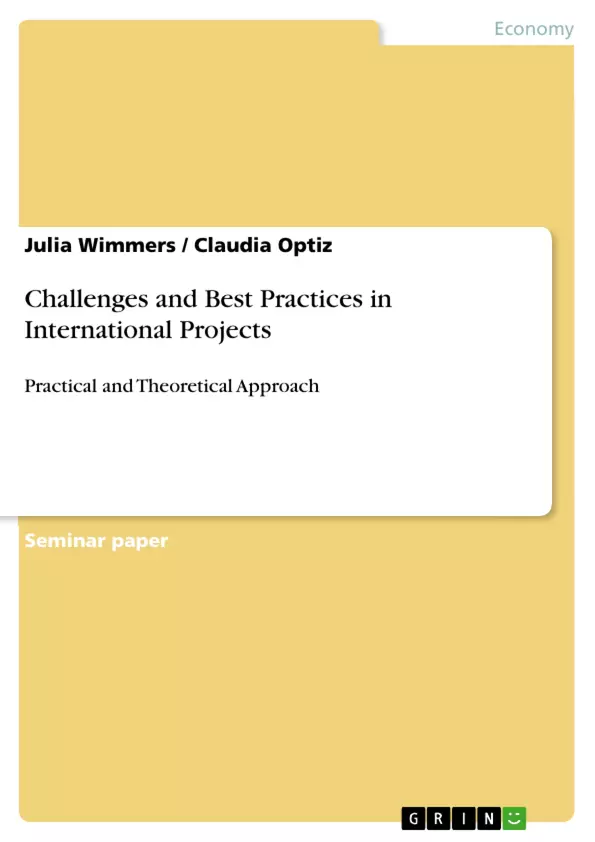In this assignment the authors will look into the subject of challenges and best practices in international projects. A single examination of all the various challenges in the world of global project management like multicultural communication, geographical distance or asynchronous interactions - resulting from multiple systems happening and taking place in more than one location and are requiring different technological knowledge for e.g. - is confronted to a broad presentation, examination and evaluation of best practices: namely concrete business orientated solutions like global teams, collaborative tools or global project organizations. The theoretical introductory part exposes lack of sensitivity to local cultures, the general issue of complexity which arises in lack of control, variety of regulations and rules, different time zones and also the “treatment of the international project as a standard project” as main challenges for and reasons for failure of many international projects. All these rather impeding and logically challenging findings are visibly summarized in the “Five Dimensions of IP” figure, concluding that there are five dimensions which will affect every project in a different manner and in different decrees of intensity. Next, there is the description and visualization of new, interesting international PM tools like the risk register, quality gates. Additionally the authors come up with general rules and advice as the agreement on binding communication rules, templates and one language for successfully working global project team. In the last part the uneven challenges and best practices couples are kind of “married” by presenting two successful international projects: The SWAP project from the leading central European energy supply company OMV, where the superior project manager Barbara Krappinger succeeded in overcoming many cultural and geographical challenges and a major event management project from the Siemens.
Inhaltsverzeichnis (Table of Contents)
- Executive Summary
- Table of Content
- List of Abbreviations
- List of Figures
- 1 Introduction
- 2 Problem Definition
- 3 Objectives
- 4 Methods
- 5. Main part
- 5.1 Definition of international projects
- 5.2 Challenges in international projects
- 5.2.1 Seven main issues in IPs according to LIENTZ & REA (2003)
- 5.2.2 The five Dimensions of IPs according to BINDER et al (2010)
- 5.3 Best Practices (JW)
- 5.3.1 A model of success factors for global PM
- 5.3.1.1 Global teams
- 5.3.1.2 Global communication
- 5.3.1.3 Global organizations
- 5.3.1.4 Collaborative tools and techniques
- 5.3.1.5 Global Risk Factors
- 5.3.2 Practical examples (JW)
- 5.3.1 A model of success factors for global PM
- 6 Results
- 7 Conclusion
- 8 ITM
Zielsetzung und Themenschwerpunkte (Objectives and Key Themes)
This assignment examines the challenges and best practices in international projects, focusing on the "international" and "global" aspects. The primary objective is to contrast the challenges faced by most international projects with best practices that provide solutions, hints, and ideas to overcome these challenges effectively.
- Identifying the key challenges faced by project managers in international projects, such as cultural differences, language barriers, and geographical distance.
- Exploring the best practices for managing these challenges, including the use of global teams, communication strategies, collaborative tools, risk management techniques, and organizational structures.
- Highlighting the importance of cultural awareness, respect, tolerance, transparency, and regular communication in successful international project management.
- Analyzing practical examples from real-world projects to illustrate the application of best practices in overcoming challenges.
- Presenting a holistic approach to international project management by incorporating various management disciplines, including human resource management, marketing, financial management, business law, economics, leadership, and research methods.
Zusammenfassung der Kapitel (Chapter Summaries)
The paper begins by introducing the challenges of international projects, contrasting them with standard projects. It emphasizes the complexities arising from cultural and language differences, geographical distances, and diverse organizational structures. The authors explore two prominent models for understanding these challenges: the seven main issues identified by Lientz & Rea and the five dimensions of Binder et al.
The paper then transitions into the realm of best practices, offering a comprehensive framework for success in international projects. This framework encompasses five key success factors: global teams, global communication, global organizations, collaborative tools and techniques, and global risk factors. Each of these factors is discussed in detail, highlighting their relevance, potential benefits, and practical implementation strategies.
Two practical examples, the SWAP project from OMV and the EURO 2008 event management project from Siemens, are presented to illustrate the application of best practices in real-world scenarios. The paper concludes with a summary of key learnings and a reflection on the overall importance of a holistic approach to international project management, emphasizing the need for cultural understanding, transparency, and effective communication strategies.
Schlüsselwörter (Keywords)
The primary keywords and focus topics of this work include: international project management, cultural differences, language barriers, geographical distance, global teams, communication strategies, collaborative tools, risk management, organizational structures, cultural awareness, respect, tolerance, transparency, communication, project success, stakeholder involvement, and best practices.
- Quote paper
- Julia Wimmers (Author), Claudia Optiz (Author), 2010, Challenges and Best Practices in International Projects, Munich, GRIN Verlag, https://www.grin.com/document/161643



